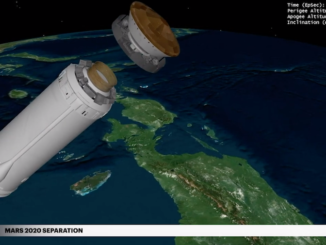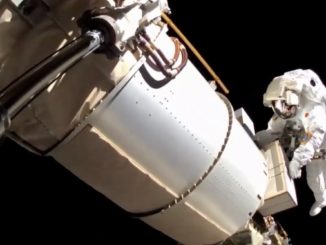
For the first time since the end of the shuttle program, a trio of T-38 jets cruised down the former Shuttle Landing Facility carrying astronauts who were preparing for launch. As they climbed out of their aircraft, NASA astronauts Butch Wilmore and Suni Williams, each donned back ball caps emblazoned with “Crew Flight Test,” the name of their forthcoming mission.
The pair will serve as the commander and pilot respectively as they fly Boeing’s Starliner spacecraft to the International Space Station no earlier than May 6. As the mission name suggests, this will be the first time the spacecraft ferries astronauts to the orbiting outpost.
“We love Florida. We love Kennedy Space Center because this is where you launch humans into space,” Wilmore said. “And the opportunity finally to fly in here again in our T-38s and we know that in less than two weeks, the next flight we take, we’ll be laying on our backs this time when we launch into the heavens and we leave this planet.”
Wilmore and Williams were joined by some of the T-38 training crew as well as fellow NASA astronauts Mike Fincke, the backup astronaut for the CFT mission, and Jessica Wittner, a member of the class of the 2021 astronaut candidate class.

With them in spirit was the last crew to fly a test mission for NASA: Bob Behnken and Doug Hurley of the SpaceX Demo-2 flight. During their remarks to the press on Thursday, Williams said they offered words of comfort.
“As a matter of fact, I just got a text from Bob last night and he was pretty pumped that we’re coming down here,” Williams said. “The one thing we were chatting about is May 6 is our launch day. There’s a lot of things between now and then. May 6 isn’t magical and he said, ‘If you get a scrub it actually is a little bit nice because it sort of takes the pressure off.’”
Standing in front of their T-38’s Williams reflected on what was going through her mind as they flew over KSC and by the launch pad at Space Launch Complex 41 where they will launch in less than two weeks.
“I was part of the original cadre that got to put the topping piece on the crew access arm for pad 41 that we’re going to fly out of,” Williams said. “And to see not only see that pad transition while they were flying other Atlas 5’s, doing other payloads, to have them turn that into a human-rated pad is just incredible.”
https://twitter.com/AstroIronMike/status/1783557592528072821
Certification nearly complete
The arrival of the CFT astronauts comes on the second day of the flight readiness review at NASA’s Kennedy Space Center. Teams across NASA, Boeing and ULA were poring over data regarding Starliner itself and the availability of the ISS to receive the spacecraft. They ultimately polled “go” to move forward with the mission and target a May 6 launch date.
“The team has practiced [simulations], run models, but there’s nothing like flying in the space environment,” said Jim Free, NASA’s associate administrator. “We’re going to learn from this test flight. I’m looking forward to us increasing our knowledge and understand and proving a new spacecraft.”
Before Starliner can arrive at the orbiting outpost, SpaceX needs to undock the Cargo Dragon spacecraft that has been stationed at the space-facing port of the Harmony module and bring it back to splash down off the coast of Florida. On Thursday, NASA said it was punting the undocking procedure from Friday to Sunday “due to unfavorable weather conditions in the splashdown zones.”
https://twitter.com/therealdjflux/status/1783474870832988162
Following that, the three astronauts and one cosmonaut of the Crew-8 mission will hop back into their Crew Dragon, named Endeavour, and relocate it from the Earth-facing port to the space-facing port to clear the way for Starliner.
“On the station side, we’ve intentionally cleared our flight plan, our vehicle traffic and our schedules, but we’ve got a really large window to accommodate the CFT mission,” said Dana Weigel, NASA ISS Program manager. “So if, for whatever reason, we need more time for the mission in the run-up to launch or onboard, there is no issue at all accommodating a longer mission duration.”
The mission profiled is designed to last a little more than a week. If for some reason they are not able to launch on May 6, they do have backup dates on May 7, 10 and 11.
Steve Stich, the manager of NASA’s Commercial Crew Program, noted that there are a couple key items that need to be completed between now and launch day. He said at Space Launch Complex 41, they will be swapping out a valve that provides replenishment of liquid oxygen for the Atlas 5’s first stage.
Stich noted that when they inspected the valve, ULA found “some particulate matter in the system,” which they wanted to check more closely. Upon further inspection, they decided that it made sense to replace the valve.
“And this is on the ground side. This is not on the flight vehicle side. We see this at lots of different launch pads,” Stich said. “We had similar kinds of problems with shuttle and so, we’ll work through it and clear that.”
He added that “out of an abundance of caution,” they are also going to review the contingency plans on the Starliner parachute system. Specifically, they are looking at the two small parachutes that pull off the forward heat shield to expose the drogue parachutes. The drogues are what initially slow down the vehicle before the main parachutes deploy.
“If one of those those two forward heat shield parachutes doesn’t deploy, we want to go back and check that analysis one more time with the latest trajectory, the latest vehicle, the latest properties and the center of gravity,” Stich said. “So, those are really the two big things that I say we have in work, but other than that, we’ve closed out the certification.”
The international partners of the space station also polled ‘go’ regarding their readiness to accept the Starliner as a visiting spacecraft.
On Friday, teams will go through essentially a dry dress rehearsal of the mission, which will include having the crew don their flight suits and go through the process that they will experience on launch day. Asked about their confidence in their ticket to ride, Wilmore said they are ready.
“One thing I’ve heard from these two guys on the right time and again, we will not fly until we’re ready. And that’s from the top,” Wilmore said, gesturing to members of Boeing leadership. “We’ve had a few delays because we weren’t ready.”
“We wouldn’t be here if we weren’t ready. We are ready, the spacecraft’s ready and the teams are ready.”
The results are in and after an extensive review of the mission and our readiness, we’re GO to proceed with launch preparations, targeting a late May 6 EDT/early May 7 UTC launch! https://t.co/oXeKo4Ef3a
— Ed Van Cise (@Carbon_Flight) April 25, 2024



